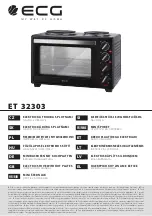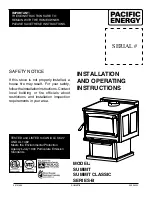
18
004778530 - 11/09/2020
3 HANDLING AND
TRANSPORT
It is advisable to wait until the stove arrives at the place
where it will be installed before unpacking it.
The stove is supplied with all its parts.
Pay attention to the stove’s tendency to oscillate.
Avoid sudden movements and sharp tugs when lifting
the stove.
Make sure the lifting capacity of the lift truck is more
than the weight of the stove. The person manoeuvring
the lifting means is held completely responsible for lifting
loads.
Do not let children play with the packaging materials (film,
polystyrene). Suffocation hazard!
4 TYPE OF FUEL
The appliance is to be fed preferably with mature beech
or birch wood or with lignite briquettes 25 or 33 cm.
Humidity must not exceed 25%.
The recommended amount of wood is indicated in the
technical data table.
Each type of wood has different characteristics that also
influence combustion yield.
It is forbidden to burn: pieces of bark, wood treated with
varnish, pressed wood panels, coal, plastic materials; in
this case, the guarantee on the appliance is no more valid.
Despite the User being responsible for verifying the
characteristics of the wood use, we must also specify that:
•
Use of pinewood (pine, fir) is not recommended as
it contains high quantities of resin substances that
quickly clog the flue.
•
IMPORTANT: burning wood types rich of aromatic
oils (e.g. eucalyptus, myrth, etc.) will cause the rapid
corrosion of the internal parts of the appliance.
Note that any damage to the product or its components
due to elements outside of such product is not covered
by the warranty and therefore no claims of this type can
be made to the manufacturer.
The declared nominal yield of the chimney is obtained by
burning the right quantity of wood, making sure not to
overload the combustion chamber. The ideal length of
the wood is provided by the length of the log holder.
Overloading the stove can cause damage or deformation
of the product.
The reference standard for the fuel used are UNI/ISO
17225-1 - UNI/ISO 17225-5 “Forest, plantation and other
virgin wood”.
5 PREPARING THE PLACE
OF INSTALLATION
5.1 SAFETY PRECAUTIONS
The user is responsible for the work carried out in the
area where the stove is installed; the user is likewise
responsible for checking the various installation solutions
proposed.
The user must comply with all the local, national and
European rules and regulations.
If the floor does not have a sufficient load-bearing
capacity, it is advisable to use a load-distributing plate
of an appropriate size.
The appliance must be installed on a floor with an
adequate carrying capacity
The stove assembly and disassembly operations must
be carried out by skilled technicians only.
The qualifications and effective expertise of such skilled
technicians should be verified.
Before starting the assembly or dismantling phases of
the machine, the installer must comply with the safety
precautions as established by law, and in particular as
regards:
A) he must not work in adverse conditions;
B) he must be in perfect psychophysical condition to
work and ensure that the individual and personal
accident prevention devices are sound and in perfect
working order;
C) he must wear accident prevention gloves;
D) he must wear safety shoes;
E) he must make sure that the area he is working in
for assembling/dismantling the stove is free from
obstacles.
















































